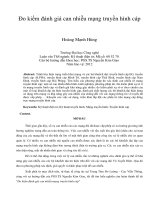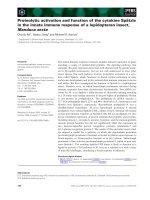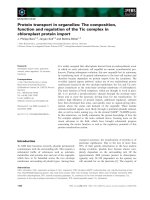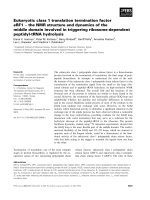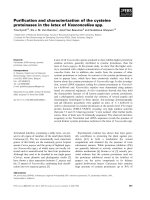PhD dissertation in economics microcredit and welfare of the rural households in vietnam
Bạn đang xem bản rút gọn của tài liệu. Xem và tải ngay bản đầy đủ của tài liệu tại đây (2.03 MB, 248 trang )
MINISTRY OF EDUCATION AND TRAINING
UNIVERSITY OF ECONOMICS HO CHI MINH CITY
*****
Pham Tien Thanh
MICROCREDIT AND WELFARE OF THE
RURAL HOUSEHOLDS IN VIETNAM
PHD DISSERTATION IN ECONOMICS
HO CHI MINH CITY, 2018
MINISTRY OF EDUCATION AND TRAINING
UNIVERSITY OF ECONOMICS HO CHI MINH CITY
*****
Pham Tien Thanh
MICROCREDIT AND WELFARE OF THE
RURAL HOUSEHOLDS IN VIETNAM
Major: Development Economics
Code: 9310105
PHD DISSERTATION IN ECONOMICS
ACADEMIC ADVISORS
1. Dr. PHAM KHANH NAM
2. Assoc. Prof. Dr. NGUYEN HUU DUNG
HO CHI MINH CITY, 2018
i
COMMITMENTS
I hereby declare that this dissertation is my own work and it has not been
previously submitted for a degree elsewhere. While my work contains information
from works done by other authors, all these references have been explicitly cited.
To the best of my knowledge, I would like to certify that the above statements are
true.
The dissertation has been done under the supervision of Dr. Pham Khanh
Nam and Assoc.Prof. Dr. Nguyen Huu Dung, the University of Economics,
Hochiminh City. This work was also done under the advice of Assoc. Prof. Dr.
Katsuhiro Saito, the University of Tokyo during my fellowship period granted by
the World Bank Robert S. McNamara at the University of Tokyo, Japan.
Pham Tien Thanh
ii
ACKNOWLEDGEMENT
I would like to express my deepest gratitude to my academic supervisors, reviewers,
colleagues, family and friends for their support during the time I conduct my Ph.D.
dissertation.
iii
TABLE OF CONTENTS
COMMITMENTS ........................................................................................................ i
ACKNOWLEDGEMENT ..........................................................................................ii
TABLE OF CONTENTS .......................................................................................... iii
ABBREVIATIONS................................................................................................. viii
LIST OF TABLES ..................................................................................................... ix
LIST OF FIGURES.................................................................................................... xi
CHAPTER 1 - INTRODUCTION .............................................................................. 1
1.1. Backgrounds ...................................................................................................... 1
1.2. Research problems ............................................................................................ 3
1.2.1. Accessibility to microcredit ........................................................................ 3
1.2.2. Microcredit and adoption of improved rice varieties.................................. 4
1.2.3. Impact of microcredit on households’ welfare ........................................... 6
1.2.4. Microcredit and health shock ...................................................................... 8
1.3. Research objectives ........................................................................................... 9
1.4. Scopes of research ............................................................................................. 9
1.5. Research data .................................................................................................. 10
1.6. Research methods............................................................................................ 10
1.6.1. Quantitative methods ................................................................................ 10
1.6.2. Qualitative methods .................................................................................. 11
1.7. Contribution of the research ............................................................................ 11
1.7.1. Theoretical contributions .......................................................................... 11
1.7.2. Practical contributions .............................................................................. 12
1.8. Organization of the research ........................................................................... 13
CHAPTER 2 – LITERATURE REVIEW ................................................................ 14
2.1. Overview of microcredit ................................................................................. 14
2.1.1. Some definitions ....................................................................................... 14
2.2.2. Characteristics of microcredit ................................................................... 15
2.2. Theory ............................................................................................................. 16
iv
2.2.1. Overview of rural credit market ................................................................ 16
2.2.2. Asymmetric information ........................................................................... 19
2.2.3. Theories on accessibility to credit ............................................................ 21
2.2.3.1. Theory of Choice (Demand for Credit) .............................................22
2.2.3.2. Theory of Credit Rationing ................................................................23
2.2.4. Theoretical framework of outreach of microcredit ................................... 26
2.2.5. Farm household model under credit constraint......................................... 27
2.2.5.1. Producer Problem ...............................................................................28
2.2.5.2. Consumer Problem.............................................................................28
2.2.5.3. Worker Problem .................................................................................29
2.2.5.4. Farm Household Model with Credit ..................................................30
2.3. Empirical studies ............................................................................................. 31
2.3.1 Determinants of rural households’ accessibility to microcredit ................ 31
2.3.2. Impact of microcredit on adoption of the improved rice varieties ........... 36
2.3.3. Impact of microcredit on living standard .................................................. 38
2.3.1. Empirical studies in the world ..............................................................39
2.3.2. Empirical studies in Vietnam ................................................................40
2.3.4. Impact of health shocks and role of microcredit....................................... 43
2.3.4.1. Impacts of health shocks ....................................................................43
2.3.4.2. Strategies to cope with Health Shocks and Role of Microcredit .......44
2.4. Definitions of welfare ..................................................................................... 47
2.5. Logical framework of impact evaluation of microcredit on welfare .............. 48
CHAPTER 3 – OVERVIEW OF MICROCREDIT ................................................. 51
3.1. Microcredit in the world ................................................................................. 51
3.2. Microcredit in rural Vietnam .......................................................................... 53
3.2.1. Microcredit providers................................................................................ 53
3.2.2. Credit activities and clients ....................................................................... 58
3.2.3. Poverty reduction role of microcredit ....................................................... 60
v
CHAPTER 4 – DETERMINANTS OF ACCESSIBILITY TO MICROCREDIT ... 61
4.1. Research method ............................................................................................. 61
4.1.1. Estimation strategy.................................................................................... 62
4.1.2. Selection of variables ................................................................................ 65
4.1.2.1. Dependent variable ............................................................................65
4.1.2.2. Explanatory Variables ........................................................................65
4.1.3. Research hypotheses ................................................................................. 67
4.2. Research data .................................................................................................. 69
4.2.1. Data source ................................................................................................... 69
4.2.2. Research sample ........................................................................................... 70
4.2.3. Descriptive statistics..................................................................................... 70
4.3. Results and discussions ................................................................................... 73
CHAPTER 5 – MICROCREDIT AND ADOPTION OF IMPROVED RICE
VARIETIES .............................................................................................................. 81
5.1. Research method ............................................................................................. 81
5.1.1. Estimation strategy.................................................................................... 81
5.1.2. Selection of variables ................................................................................ 85
5.1.2.1. Dependent variables ...........................................................................85
5.1.2.2. Independent variables .......................................................................86
5.1.3. Research hypotheses ................................................................................. 87
5.2. Research data .................................................................................................. 87
5.2.1. Data source ................................................................................................... 87
5.2.2. Research sample ........................................................................................... 87
5.2.3. Descriptive statistics..................................................................................... 88
5.3. Results and discussions ................................................................................... 90
CHAPTER 6 – IMPACT EVALUATION OF MICROCREDIT ON WELFARE 102
6.1. Research method ........................................................................................... 102
6.1.1. Estimation strategy.................................................................................. 102
6.1.1.1. Propensity Score Matching (PSM) ..................................................102
vi
6.1.1.2. Difference in Difference (DID) .......................................................103
6.1.1.3. PSM-DID .........................................................................................104
6.1.2. Selection of variables .............................................................................. 105
6.1.2.1. Microcredit variable .........................................................................105
6.1.2.2. Variables for calculation of propensity score ..................................106
6.1.2.3. Welfare variables .............................................................................106
6.1.3. Research hypotheses ............................................................................... 107
6.2. Research data ................................................................................................ 108
6.2.1. Data source .............................................................................................. 108
6.2.2. Research sample...................................................................................... 108
6.2.3. Descriptive statistics ............................................................................... 109
6.3. Results and discussions ................................................................................. 109
6.3.1. Propensity score and balancing test ....................................................... 109
6.3.2. Average impact of microcredit program ................................................. 111
CHAPTER 7 – ROLE OF MICROCREDIT IN MITIGATING THE EFFECTS OF
HEALTH SHOCKS ................................................................................................ 118
7.1. Research method ........................................................................................... 118
7.1.1. Estimation strategy.................................................................................. 118
7.1.2. Selection of variable ............................................................................... 120
7.1.2.1. Dependent variables ........................................................................120
7.1.2.2. Health shocks variables ....................................................................120
7.1.2.3. Microcredit variable .........................................................................121
7.1.2.4. Other control (explanatory) variables ..............................................122
7.1.3. Research hypotheses ............................................................................... 123
7.2. Research data ................................................................................................ 123
7.2.1. Data source ................................................................................................. 123
7.2.2. Research sample ......................................................................................... 124
7.2.3. Descriptive statistics................................................................................... 124
7.3. Results and discussions ................................................................................. 126
vii
7.3.1. Are health shocks unanticipated? ........................................................... 126
7.3.2. First stage results using instrumental variables ...................................... 127
7.3.3. Illness/ Disease/ Injury of working-age members (HS1W) .................... 130
7.3.4. Illness/ Disease/ Injury of any members (HS1A) ................................... 133
CHAPTER 8 – CONCLUSIONS............................................................................ 135
8.1. Objective 1: Determinants of accessibility o microcredit ............................. 135
8.1.1. Summary ................................................................................................. 135
8.1.2. Policy implications................................................................................. 136
8.1.3. Limitations and further studies .............................................................. 138
8.2. Objective 2: Microcredit and adoption of improved varieties ...................... 139
8.1.1. Summary ................................................................................................. 139
8.2.2. Policy implications................................................................................. 140
8.2.3. Limitations and further studies .............................................................. 141
8.3. Objective 3: Impact evaluation of microcredit on welfare ........................... 142
8.3.1. Summary ................................................................................................. 142
8.3.2. Policy implications................................................................................. 143
8.3.3. Limitations and further studies .............................................................. 144
8.4. Objective 4: Role of microcredit in mitigating the effects of health shocks 145
8.4.1. Summary ................................................................................................. 145
8.4.2. Policy implications................................................................................. 146
8.4.3. Limitations and further studies .............................................................. 146
REFERENCE .......................................................................................................... 147
Reference in the word .......................................................................................... 147
Reference in Vietnam ........................................................................................... 165
Websites ............................................................................................................... 169
APPENDIX ............................................................................................................ 171
viii
ABBREVIATIONS
Abbr
Meanings
MF
Microfinance
MFIs
Microfinance Institutions
PCFs
People’s Credit Funds
ROSCAs
Rotating Savings Credit Associations
VBSP
Vietnam Bank for Social Policies
VBARD
Vietnam Bank for Agriculture and Rural Development
VPSC
Postal Savings Company
ix
LIST OF TABLES
Table 2.1 - Welfare indicators ...................................................................................47
Table 3.1 - Microcredit trend in the world ................................................................52
Table 3.2 - Top 10 microcredit providers in the world .............................................52
Table 3.3 - Microcredit providers in Vietnam ..........................................................59
Table 3.4 - Living standards of clients before and after borrowing. .........................60
Table 4.1 - Variables for analysis of determinants of accessibility to microcredit...67
Table 4.2 – Description of loans obtained ................................................................71
Table 4.3 - Characteristics of variables for analysis of determinants of accessibility
to microcredit ............................................................................................................72
Table 4.4 - Estimated results of determinants of accessibility to microcredit – Whole
sample........................................................................................................................75
Table 4.5 - Estimated results of determinants of accessibility to microcredit – Nonpoor sample ...............................................................................................................79
Table 4.6 - Estimated results of determinants of accessibility to microcredit – Poor
sample........................................................................................................................80
Table 5.1 - Variables used for analyzing impact of microcredit on adoption...........86
Table 5.2 - Characteristics of adoption variables ......................................................88
Table 5.3 - Characteristics of variables that affect adopting decision ......................89
Table 5.4 - Microcredit and adoption of improved rice varieties - IV 2SLS using 3
IVs .............................................................................................................................91
Table 5.5 - Microcredit and adoption of improved rice varieties - IV 2SLS using 1
IV ...............................................................................................................................91
Table 5.6 - Microcredit and adoption of improved rice varieties .............................93
Table 5.7 - Microcredit and adoption of improved rice varieties – Poor and nonpoor sample .............................................................................................................101
Table 5.8 - Impact of microcredit on other investment activities ...........................101
Table 6.1 - Definition of welfare variables .............................................................107
Table 6.2 - Probit estimations for calculation of propensity score .........................110
x
Table 6.3 – Balancing test .......................................................................................111
Table 6.4 - Impact of microcredit on income and total output value ......................112
Table 6.5 - Impact of microcredit on food expenditure ..........................................116
Table 6.6 - Impact of microcredit on accumulation of durable assets ....................117
Table 7.1 - Types of health shock ...........................................................................121
Table 7.2 - Microcredit borrowed by households ...................................................122
Table 7.3 - Descriptive statistics of variables for used analysis of health shocks ..125
Table 7.4 - Unanticipation of health shocks ...........................................................127
Table 7.5 – First stage results using IV for HS1W .................................................128
Table 7.6 – First stage results using IV for HS1A ..................................................128
Table 7.7 - Impact of health shocks on income and labor and the role of microcredit
using VFE................................................................................................................129
Table 7.8 - Impact of health shocks on consumption and the role of microcredit
using VFE................................................................................................................129
xi
LIST OF FIGURES
Figure 2.1 – Credit constraint and unconstraint ........................................................25
Figure 2.2 - Analytical framework of impact of microcredit on welfare..................42
Figure 2.3 - Conceptual framework of impacts of health shock ...............................44
Figure 2.4 - Logical framework on impact evaluation of credit on welfare .............49
Figure 2.5 – Analytical framework on accessibility to microcredit and its impact on
welfare .......................................................................................................................50
Figure 3.1 – Microfinance providers in Vietnam ......................................................53
xii
1
CHAPTER 1 - INTRODUCTION
1.1. Backgrounds
Poverty reduction, access to education, clean water, sanitary, health care, etc.
are the top concerned among 17 Sustainable Development Goals - SDGs) which
formerly was Millennium Development Goals (MGDs). They are the important
issues and attract the attention of every country, especially the developing countries
like Vietnam. During the past decades, Vietnam has obtained remarkable
achievements in the socio-economic development and poverty reduction.
Statistics show that the poverty rate has declined from 37.4 percent in 1998
to 5.8% in 2016 (Demombynes & Vu, 2015; GSO, 2016). The report also shows
that the poverty rate in 2016 in rural areas (7.5%) is nearly four times higher than
that in urban areas (2%)1. The statistics indicate that a large number of rural
households still live in poverty under poor living standards and suffer from the lack
of socio-economic opportunities. Income of the households in rural area is rather
low. In particular, a report by GSO (2016) shows that per capita income per month
of the rural households is, on average, 2,437 thousand VND. In the rural, per capita
income per month of the bottom quintile (the poorest) is 676 thousand VND, the
second bottom (the near-poor) 1,246 thousand VND and the top quintile (the
richest) 5,669 thousand VND. Therefore, it indicates that income of the poorest is
around 8.4 times lower than that of the richest, which is a great gap. Consumption
of the rural households is quite low. In particular, a report by GSO (2014) shows
that per capita expenditure per month of the rural households is, on average, 1,609
thousand VND. More specific, per capita expenditure per month of the bottom
quintile (the poorest) is 834 thousand VND, the second bottom (the near-poor)
1,154 thousand VND and the top quintile (the richest) 2,576 thousand VND, which
indicates a big gap between the poorest and the richest in terms of expenditure.
1
New poverty line (Measured by income per capita per month) in 2016 is 630 and 780 thousand
VND in rural and urban areas, respectively.
2
Poverty reduction, income improvement and good health, especially in the
rural area, are the most concerned issues among the 17 Sustainable Development
Goals. In the world and in Vietnam, many programs and activities have been
implemented to achieve these goals, for instance, training, agricultural extension,
agricultural technology, finance, job creation, etc. Among them, credit is considered
as the most important factors in income-generating activities since the rural
households, especially the poor, normally face financial constraint. Without
accessibility to formal credit support, poor farmers are unable to expand their
production and improve their living conditions (Li et al., 2011).
As above-mention, a large number of rural households in Vietnam are still
living in poverty. The poor have high demand for credit; however, credit market in
rural Vietnam normally faces the problem of demand excessing supply.
Thenceforth, the poor have difficulty in accessing formal credit due to the lack of
collateral. In rural Vietnam, formal credit is mainly provided by the Vietnam Bank
for Agriculture and Rural Development and Vietnam Bank for Social Policies (Ho
& Duc, 2015), and recently by microfinance institutions.
Inability to obtain formal credit has inhibited farmers from improving their
living conditions. Therefore, farmers may rely on informal credit sources to support
their production and consumption even though they must pay a much higher interest
rate, which may push them deeper into ‘vicious debt circle’ with less repayment
capacity. The reasons why farmers still accept the high interest rate from informal
sources are its collateral-free merit and quick borrowing procedure.
Since its birth, microcredit programs provide the poor with opportunities to
be more accessible to formal and semi-formal credit sources (Li et al., 2011). Some
merits of microcredit are collateral-free and to serve the poor. By definition,
microcredit is defined as a small loan granted to the poor so that they can run
production or do business to generate income and improve their well-being
(Microcredit Summit, 1997). Microcredit is found by many researchers and
practitioners to an effective instrument to improve well-being of the poor.
3
Therefore, this research aims to examine accessibility to microcredit and its
economic impacts on welfare of rural households. Thenceforth, relevant policies
will be suggested to support the poor with better access to microcredit sources and
improve the effectiveness of microcredit in investment, thereby increasing their
living standard. Therefore, to capture these primary research objectives, the
following specific objectives will be included and analyzed:
1.2. Research problems
1.2.1. Accessibility to microcredit
Morduch and Haley (2002) state that credits can help the poor to improve
their living standards or at least cover their living expenses. However, a research by
Brau and Woller (2004) find that the poor have difficulties in accessing to formal
credit sources; particularly, the poor in the developing countries have more
difficulties in accessing than those in the developed countries. In Vietnam, many
rural households normally have difficulties in accessing to credit, especially poor
households, households in remote areas, the minority ethnic groups, or households
operating in such fields with high risk as aquaculture, etc., These households always
have high demand for credit (Duong & Izumida, 2002) but they have some
difficulties in borrowing from semi-formal and formal credit sources such as banks
or financial institutions. Thenceforth, many households have to borrow from
informal credit sources such as friends, relatives, money-lender, etc. The
Government has taken a lot of effort to support the rural households with accessing
to semi-formal and formal credit but the result is still rather limited. To increase
efficiency of financial services as well as better serve the poor, it is essential to
understand the factors that affect participants in microcredit of the rural households,
thereby implying appropriate policies. Therefore, this study is conducted to
investigate the factors that affect the accessibility to microcredit sources.
The objective of microcredit programs is to serve the poor. However, a
research by Nguyen (2008) finds that the number of poor households with access to
4
microcredit program is lower than that of the non-poor. Thenceforth, this research
will investigate whether the poor households are better able to participate in
microcredit programs that the non-poor.
In addition, one of the attributes of microcredit programs is that the target
clients are women. Therefore, this research also investigates the role of gender in
participation in microcredit. In particular, this research examines whether the
female household heads can have better accessibility to microcredit sources than the
male counterparts. This objective is conducted using models with binary dependent
variable such as Probit or Logit.
Research question 1: What are determinants of accessibility to microcredit
of rural households? Do poverty status and gender matter?
1.2.2. Microcredit and adoption of improved rice varieties
Agriculture plays a crucial role in the economy of every country, especially
the developing countries. In Vietnam, agricultural sector contributes nearly 33
billion USD to gross domestic product (GDP) in 2015, around 17-percent share
(World bank, 2016). In addition, nearly half (46.8%) of the labor force in Vietnam
are employed in agriculture in 2013 (World bank, 2016). Agriculture contributes to
ensure food security and generate income for economic development (Datt &
Ravallion, 1996). Moreover, in the developing countries, agriculture is a major
income source of rural households that derives from domestic sales and export
(Singh et al., 1985). Therefore, the improvement of quantity and quality of
agricultural output is a focal point of the government in the developing countries
(Bonnin & Turner, 2012). However, the population in the world as well as in the
developing countries has increased more and more and the urbanization has been so
rapid, which results in less land resource for agricultural production. Thenceforth,
productivity improvement via expanding land area is no longer appropriate.
Therefore, the most possible solution to enhance production output is to adopt new
high-yielding technology.
5
Rice is considered one of the main staples in the world and developing
countries like Vietnam. In Vietnam, total area of rice farming is around 7,790
thousand hectares with total production output of 43,609 thousand ton in 2016
(GSO, 2016), which makes rice rank the first among annual crop. Rice is the
leading cultivar in terms of export volume with 4,835 thousand ton and rank second
in terms of export value with 2.1 billion USD (GSO, 2016). Rice production is an
important source of export earnings for rice economies like Vietnam. Therefore,
enhancing quantity, quality and value of rice is the urgent and important issues.
Literature documents that adoption of improved rice varieties is considered
as an effective to enhance productivity due to their attributes of short duration, high
yield and climate-resistance (Sall et al., 2000). However, the adoption of improved
varieties may only become effective in enhancing productivity when being
combined with new fertilizers and modern cultivation practices (Karanja et al.,
2003).
In practice, adoption of new technology normally incurs high initial cost and
high risk, which inhibit the farmers’ decision toward adoption, especially the
farmers with financial constraint. Several studies find that credit can facilitate the
households’ investment in agricultural innovation in general and improved varieties
in particular. This can be explained via two mechanisms (Eswaran & Kotwal, 1990;
Zeller et al., 1997; Diagne et al., 2000): (1) Credit relaxes financial constraint of the
farmers, and thereby they can invest in agriculture; (2) Credit plays a role as coping
strategies with shocks, including agricultural shocks such as natural disaster,
pestilent insect, etc.
In fact, adoption of improved cultivar varieties may be affected by farmers’
perception, education, risk attitude, knowledge and management of agricultural
extension center, and soil conditions of the area. These models are complicated
cultivation practice and require more time, labor and capital than traditional
strategies since farmer need to pay more for new and certified agricultural inputs
such as seeds or fertilizers (Chi, 2008; Dung & Thanh, 2017).
6
The previous studies only investigate the determinants of adoption of new
varieties, but do not focus on the role of credit on adopting decision. Moreover,
most of the previous studies observe the behaviors of all farmers while there are
very few studies that investigate in detail the behaviors of farmers with and without
financial constraints or poor or non-poor status. In addition, most of previous
studies only investigate the determinants of whether to adopt the improved varieties.
There are still limited number of studies on the decisions of farmers in the two
stages, including whether to adopt and intensity of adoption.
In Vietnam, there has been no empirical studies investigating the relationship
between microcredit and adoption of improved rice varieties. This study examines
the role of microcredit in two-stage decision of the farmers on adoption of improved
varieties as well as investigates in detail the behaviors of each specific group (poor
and non-poor groups). Therefore, instead of a simple model, this research employs
two-stage models such as Double-Hurdle (DH) or Heckman to clarify the farmers’
adoption decisions in two stages. For robustness check, such models as Tobit are
also applied for comparison.
Research question 2: Does microcredit enhance the farmers’ decision on
adoption of improved rice varieties in two stages, including whether to adopt and
how much to adopt?
1.2.3. Impact of microcredit on households’ welfare
Microcredit programs have been applied in many countries as a tool of
poverty reduction and hunger eradication. The impact of microcredit on living
standard of rural households has been studied by many scholars, practitioners and
policymakers. However, their findings are mixed and inconsistent.
Khandker (1998) and Yunus (2003) consider microcredit as a tool for the
goal of fighting poverty and improving welfare. Microcredit is also found to have
positive and significant effect on welfare of the rural households via improving their
consumption and/or consumption (Li et al., 2011b; Mahjabeen, 2008). It is also
7
proved that households with access to microcredit can improve their children’
health condition of (Pitt et al., 2003) or education (You & Annim, 2014).
However, some researchers argue that microcredit has insignificant effect on
households’ living standard. Coleman (2006) finds no evidence for the impact of
microcredit on less wealthy households’ living standards, while Khandker and
Koolwal (2013) contrast that only smaller landholders benefit from microcredit via
increasing their agricultural income. Takahashi et al. (2010) conclude that
microcredit has no significant impact on various outcomes, except for sales from
self-employment for the non-poor and schooling expense for the poor, thereby
indicating that microcredit has no immediate impact on poverty reduction.
In Vietnam, there have been many studies about the impact of microcredit on
the welfare of the rural households. The empirical studies show that microcredit
improves households’ welfare via increasing income, expenditure, self-employment
profits or contributing to poverty reduction (Nguyen, 2008; Quach, 2017; Lensink
& Pham, 2011; Ho & Duc, 2015). In some cases, microcredit is found to have no
impact on income, but only consumption (Phan et al., 2014).
Literature shows that the impact of microcredit on welfare is still in
argument and the results are mixed among research and depend on indicators used
to measure welfare. While there have been many researches about the role of
microcredit in Vietnam, none of these studies investigate its impact on multidimensional aspects of welfare. Therefore, this research is conducted to examine the
role of microcredit on households’ welfare reflected via income, food consumption,
and accumulation of assets. To capture to better results, this research applies various
advanced impact evaluation techniques such as Propensity Score Matching (PSM),
Difference in Difference (DID) and PSM-DID.
Research question 3: Does microcredit improve rural households’ welfare,
measured by income, total production value, food consumption and asset
accumulation?
8
1.2.4. Microcredit and health shock
A research by Banerjee and Duflo (2012) finds that when health is improved,
people can study or work better, which thereby improves their future income. In the
developing countries, the social security system is not well-organized. Thenceforth,
when households face any health problem, they normally face big trouble,
especially the poor. Sytemmatic review by Alam and Mahal (2014) reveals that
health problems may have impact on household via some channels. For instance,
when the workers in the family cannot work due to health problems, it will lead to
an increase medical expense and a decrease the household’s income. The same
outcome may happened when care-givers cannot work to give cares to other
sick/disease member. To alleviate such burden, the households with health
problems will normally use a certain coping/mitigating strategy. However, when the
social security system is less developed and the formal coping/mitigating strategies
are not availables, the households may take advantage of informal coping strategies
such as reduced consumption, informal loan, or selling assets
Regarding the role of microcredit in coping with health shock, there have
been few studies (Gertler et al., 2009; Islam & Maitra, 2012). These studies state
that households with access to microfinance can smooth their consumption better
than those without any coping strategies.
In Vietnam, impact of health shock has been researched in few studies
(Wagstaff & van Doorslaer, 2003; Wagstaff, 2007; Mitra et al., 2015; Okonogi et
al., 2015). However, neither of researches in Vietnam investigates the role of
microcredit in mitigating the impact of health shocks, especially in relation with
other outcomes. Therefore, this research has two objectives. The first aim is to
examine the impact of health shocks on the households’ change in income,
consumption and intra-household labors. The second and more important aim is to
investigate the role of microcredit in mitigating the consequence after an onset of
health shocks. Regarding the inter-relation between microcredit and mobility of
intra-household labors after an onset of health shocks, there seems to be lack of
9
literature on this issue, which thereby makes this research become innovative. This
study employs regression with Village Fixed Effect (VFE) using the data from
VHLSS in 2010 and 2012 to make comparison and capture the best results.
Research question 4: Does microcredit mitigate the adverse effects of health
shocks on income, consumption and intra-household labor mobility?
1.3. Research objectives
The primary research objective is to investigate the accessibility to
microcredit programs and its impacts on welfare. However, it is important to
capture the impact mechanism of microcredit program. Thenceforth, following
logical framework of impact evaluation in Section 2.5, this research includes the
following specific objective:
(1) Investigate the determinants of accessibility to microcredit of the rural
households; in particular, whether microcredit targets the poor and women
borrowers. Further investigation is also conducted on the poor and non-poor sample.
(2) Examine the role of microcredit in enhancing farmers’ decision on
adoption of improved rice varieties in both stages, including whether to adopt and
how much to adopt. The study decomposes research sample into the poor and nonpoor for further investigation.
(3) Evaluate the impact of microcredit on the rural households’ living
standards, measured by various indicators such as income, total production value,
food consumption, and asset accumulation.
(4) Investigate the mitigating role of microcredit when households face any
health shocks; in particular, whether microcredit reduces the adverse effects of
health shocks on income, consumption and intra-household labor mobility.
1.4. Scopes of research
Microcredit is widely provided in urban and rural areas. Both banks and
Microfinance Institutions (MFIs) provide microcredit. In addition, many
10
indicators can be used to define microcredit, welfare and health shocks. Due to
availability of data, the research scopes are as follows:
• This research focuses on the households in the rural areas in Vietnam.
• Microcredit used for analysis is defined as collateral-free and small loan (less
than 100 million VND) granted by the formal credit providers such as banks,
PCF and other mass organizations.
• This research focuses on the microcredit used for production or doing business.
Thenceforth, it may capture the long-term and sustainable impact of
microcredit on welfare.
• Welfare indicators used for analysis include total output value, revenue,
income, consumption, accumulation of assets, and non-working-age labor.
• Two types of health shocks are used for analysis, including illness/ disease/
injury of any members and working-age members.
1.5. Research data
Quantitative data. This research applies two datasets for quantitative
analysis, including Vietnam Household Living Standards Survey (VHLSS) in 2010
and 2012, and Vietnam Access to Resources Household Survey (VARHS) in 2012
and 2014. VARHS is applied to investigate the first three objectives while the
fourth objective is analyzed using VHLSS.
Qualitative data. In-depth interview and focus group are conducted in rural
areas in Tra Vinh and Long An provinces to supplement the results from
econometric model and to imply policy.
1.6. Research methods
1.6.1. Quantitative methods
This research employs different methods for investigating each specific
research objectives. Probit model using panel data is applied to investigate the
determinants of accessibility to microcredit (Research objective 1). Double-Hurdle
11
(DH), Tobit and Heckman models with cross-sectional data are used to examine
how microcredit affects farmers’ decision toward adoption of improved rice
varieties (Research objective 2). Such impact evaluation techniques as Difference
in difference (DID) and PSM-DID with panel data are applied to assess the effects
of microcredit on living standard (Research objective 3). Regression with VillageFixed-Effect (VFE) with panel data is employed to analyze the role of microcredit
in mitigating the consequence of health shocks (Research objective 4).
1.6.2. Qualitative methods
According to Merriam (1998), Bogdan and Biklen (1992), and Creswell
(2003), qualitative research may be conducted using: observation, In-depth
Interview (Face to Face, Focus group, phone), Media (Photo, Recording). This
research employs in-depth interview and focus group to capture the deeper
understanding about the research problems. Qualitative research is conducted on the
subjects associated with microcredit programs, including: (1) Borrowers from
microcredit provided by VBSP, (2) village Officials, staff of Women Union, staff of
Farmer Union, etc. at some communes; (4) Specialists in the fields of rural finance.
1.7. Contribution of the research
1.7.1. Theoretical contributions
The dissertation is an empirical work, which mainly uses applied
econometrics and models from previous studies to testify for the case of Vietnam.
However, the dissertation still makes some contributions to literature, including:
• The dissertation modifies an analytical framework on mechanisms through
which microcredit can affect farmers’ decisions on adoption of improved
rice varieties or other investment choices, then impact households’ welfare,
and finally mitigate the adverse effect of health shocks.
• The dissertation modifies and test empirical models of the determinants of
accessibility to microcredit.
